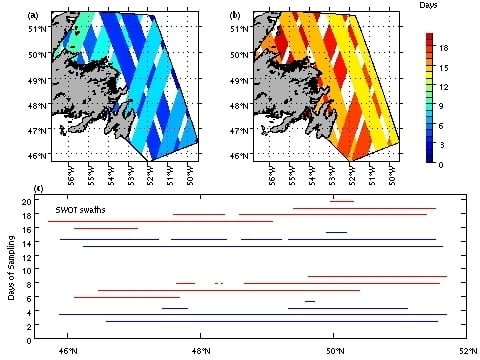Reconstruction of the Surface Inshore Labrador Current from SWOT Sea Surface Height Measurements
Abstract
:1. Introduction
2. Methods
2.1. FVCOM (4.0) Model
2.2. SWOT Simulator
2.3. Tide-gauge Data and Jason-2 Altimeter Data
2.4. SWOT Configuration
2.5. Optimal Interpolation and Surface Geostrophic Current
3. Results
3.1. Model Results and Evaluation
3.2. SWOT Simulation and Reconstruction
3.3. The Surface Inshore Labrador Current and its Surface Unit-Depth Transport
4. Summary and Discussion
5. Conclusions
Author Contributions
Funding
Acknowledgments
Conflicts of Interest
References
- Greenberg, D.A.; Petrie, B.D. The mean barotropic circulation on the Newfoundland Shelf and slope. J. Geophys. Res. 1988, 93, 15541–15550. [Google Scholar] [CrossRef]
- Han, G.; Lu, Z.; Wang, Z.; Helbig, J.; Chen, N.; de Young, B. Seasonal variability of the Labrador Current and shelf circulation off Newfoundland. J. Geophs. Res. 2008, 113. [Google Scholar] [CrossRef]
- Ma, Z.; Han, G.; Chassé, J. Simulation of circulation and ice over the Newfoundland and Labrador Shelves: the mean and seasonal cycle. Atmos.Ocean. 2015, 54, 248–263. [Google Scholar] [CrossRef]
- Han, G.; Ikeda, M. Basin-scale variability in the Labrador Sea from TOPEX/Poseidon and Geosat altimeter data. J. Geophys. Res. 1996, 101, 28325–28334. [Google Scholar] [CrossRef]
- Han, G.; Tang, C.L. Velocity and transport of the Labrador Current determined from altimetric, hydrographic, and wind data. J. Geophs. Res. 1999, 194, 18,047–18,057. [Google Scholar] [CrossRef]
- Han, G.; Tang, C.L. Interannual variations of volume transport in the western Labrador Sea based on TOPEX/Poseidon and WOCE data. J. Phys. Oceanogr. 2001, 31, 199–211. [Google Scholar] [CrossRef]
- Häkkinen, S.; Rhines, P.B. Decline of subpolar North Atlantic circulation during the 1990s. Science 2004, 304, 555–559. [Google Scholar] [CrossRef]
- Lazier, J.R.N.; Wright, D.G. Annual velocity variations in the Labrador Current. J. Phys. Oceanogr. 1993, 23, 659–678. [Google Scholar] [CrossRef]
- Chavanne, C.P.; Klein, P. Can oceanic submesoscale processes be observed with satellite altimetry? Geophys. Res. Lett. 2010, 37. [Google Scholar] [CrossRef] [Green Version]
- Chelton, D.; Schlax, M. The accuracies of smoothed sea surface height fields constructed from tandem altimeter datasets. J. Atmos, Oceanic Technol. 2003, 20, 1276–1302. [Google Scholar] [CrossRef]
- Fu, L.L.; Ubelmann, C. On the transition from profile altimetry to swath altimeter for observation global ocean surface topography. J. Atmos. Oceanic Technol. 2014, 31, 560–568. [Google Scholar] [CrossRef]
- Han, G.; Ma, Z.; de Young, B.; Foreman, M.; Chen, N. Simulation of three-dimensional circulation and hydrography over the Grand Banks of Newfoundland. Ocean Model. 2011, 40, 199–210. [Google Scholar] [CrossRef]
- Ma, Z.; Han, G.; de Young, B. Oceanic responses to Hurricane Igor over the Grand Banks: A modeling study. J. Geophs. Res. 2015, 120, 1276–1295. [Google Scholar] [CrossRef]
- Saha, S.; Moorthi, S.; Pan, H.; Wu, X.; Wang, J.; Nadiga, S.; Tripp, P.; Kistler, R.; Woollen, J.; Behringer, D.; et al. The NCEP Climate Forecast System Reanalysis (CFSR). Bull. Amer. Meteor. Sco. 2010, 91, 1015–1057. Available online: https://doi.org/10.5065/D6513W89 (accessed on 14 July 2018). [CrossRef]
- Gaultier, L.; Ubelmann, C.; Fu, L.-L. The chanllenge of using future SWOT data for oceanic field reconstruction. J. Atmos. Oceanic Technol. 2015, 33, 119–126. [Google Scholar] [CrossRef]
- Pawlowicz, R.; Beardsley, B.; Lentz, S. Classical tidal harmonic analysis including error estimates in MATLAB using T_TIDE. Comput. Geosci. 2002, 28, 929–937. [Google Scholar] [CrossRef]
- Bretherton, F.P.; Davis, R.E.; Fandry, C.B. A technique for objective analysis and design of oceanographic experiments applied to MODE-73. Deep-Sea Res. 1976, 23, 559–582. [Google Scholar] [CrossRef]
- Qiu, B.; Chen, S.; Klein, P.; Ubelmann, C.; Fu, L.-L. Reconstructability of three-dimensional upper-ocean circulation from SWOT sea surface height measurements. J. Phys. Oceanogr. 2016, 46, 947–963. [Google Scholar] [CrossRef]
- Le Traon, P.Y.; Hernandez, F. Mapping the oceanic mesoscale circulation: validation of satellite altimetry using surface drifters. J. Atmos, Oceanic Technol. 1992, 9, 687–698. [Google Scholar] [CrossRef]
- Ubelmann, C.; Cornuelle, B.; Fu, L.-L. Dynamic mapping of along-track ocean altimetry: method and performance from observing system simulation experiments. J. Atmos. Oceanic Technol. 2016, 33, 1691–1699. [Google Scholar] [CrossRef]
- Ruggiero, G.A.; Cosme, E.; Brankart, J.-M.; Sommer, J.L.; Ubelmann, C. An efficient way to account for observation error correlations in the assimilations of data from the future SWOT High-Resolution altimeter mission. J. Atmos, Oceanic Technol. 2016, 33, 2755–2768. [Google Scholar] [CrossRef]
- Han, G.; Ohashi, K.; Chen, N.; Myers, P.G.; Nunes, N.; Fischer, J. Decline and partial rebound of the Labrador Current 1993-2004: monitoring ocean currents from altimetric and CTD data. J. Geophs. Res. 2010, 115. [Google Scholar] [CrossRef]
- Behnisch, M.; Macrander, A.; Boebel, O.; Wolff, J.-O.; Schroter, J. Barotropic and deep-referenced baroclinic SSH variability derived from Pressure Inverted Echo Sounders (PIES) south of Africa. J.Geophs.Res.Oceans. 2013, 118, 3046–3058. [Google Scholar] [CrossRef]
- Petrie, B.; Anderson, C. Circulation on the newfoundland continental shelf. Atmos.-Ocean. 1983, 21, 207–226. [Google Scholar] [CrossRef]
- Le Traon, P.Y.; Klein, P.; Hua, B.L.; Dibarboure, G. Do altimeter wavenumber spectra agree with the interior or surface quasigeostrophic theory? J. Phys, Oceanogr. 2008, 38, 1137–1142. [Google Scholar] [CrossRef]
- Xu, Y.; Fu, L.-L. Global variability of the wavenumber spectrum of oceanic mesoscale turbulence. J. Phys. Oceanogr. 2011, 41, 802–809. [Google Scholar] [CrossRef]
- Xu, Y.; Fu, L.-L. The effect of altimeter instrument noise on the estimation of the wavenumber spectrum of sea surface height. J. Phys. Oceanogr. 2012, 42, 2229–2233. [Google Scholar] [CrossRef]
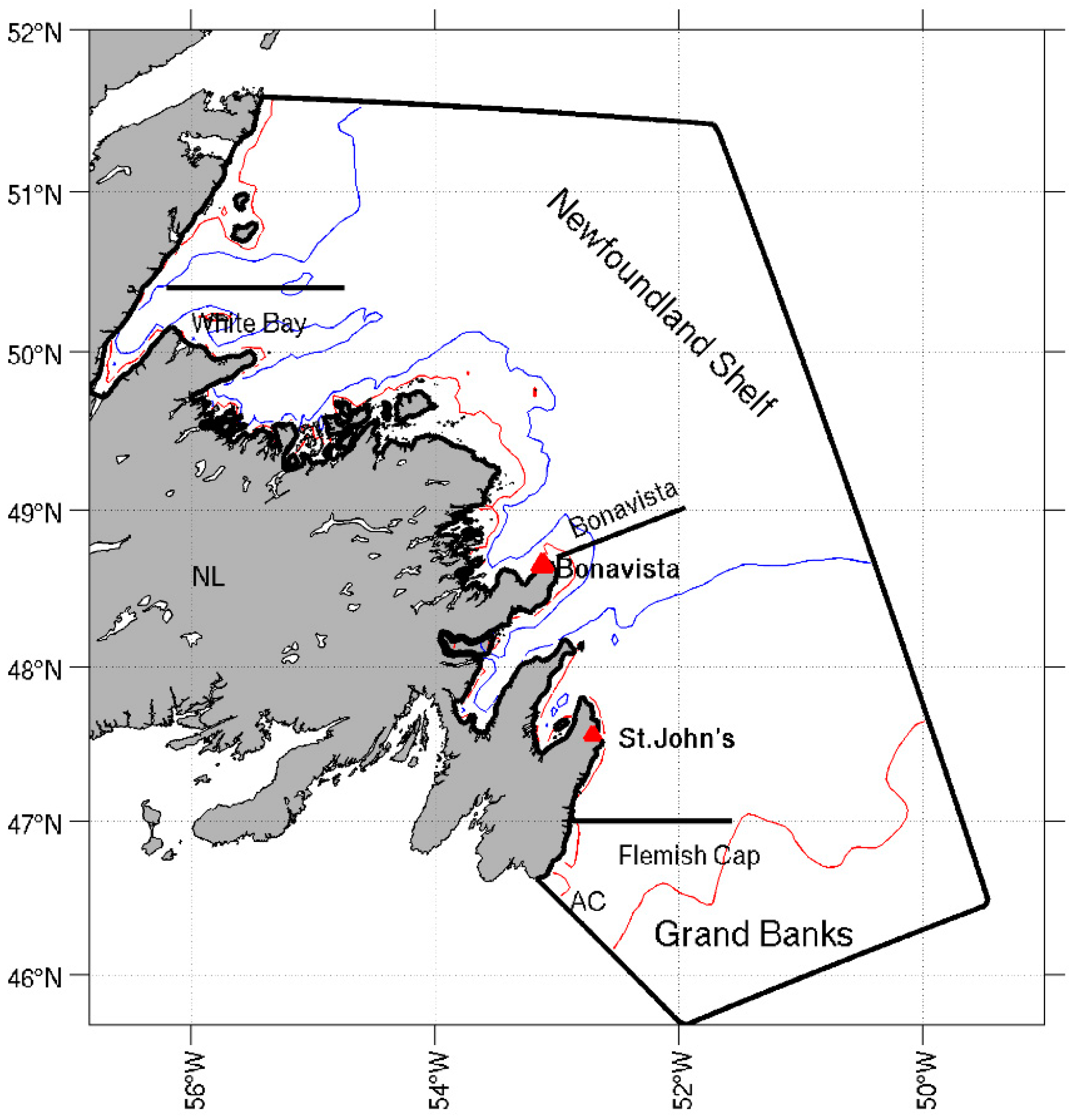
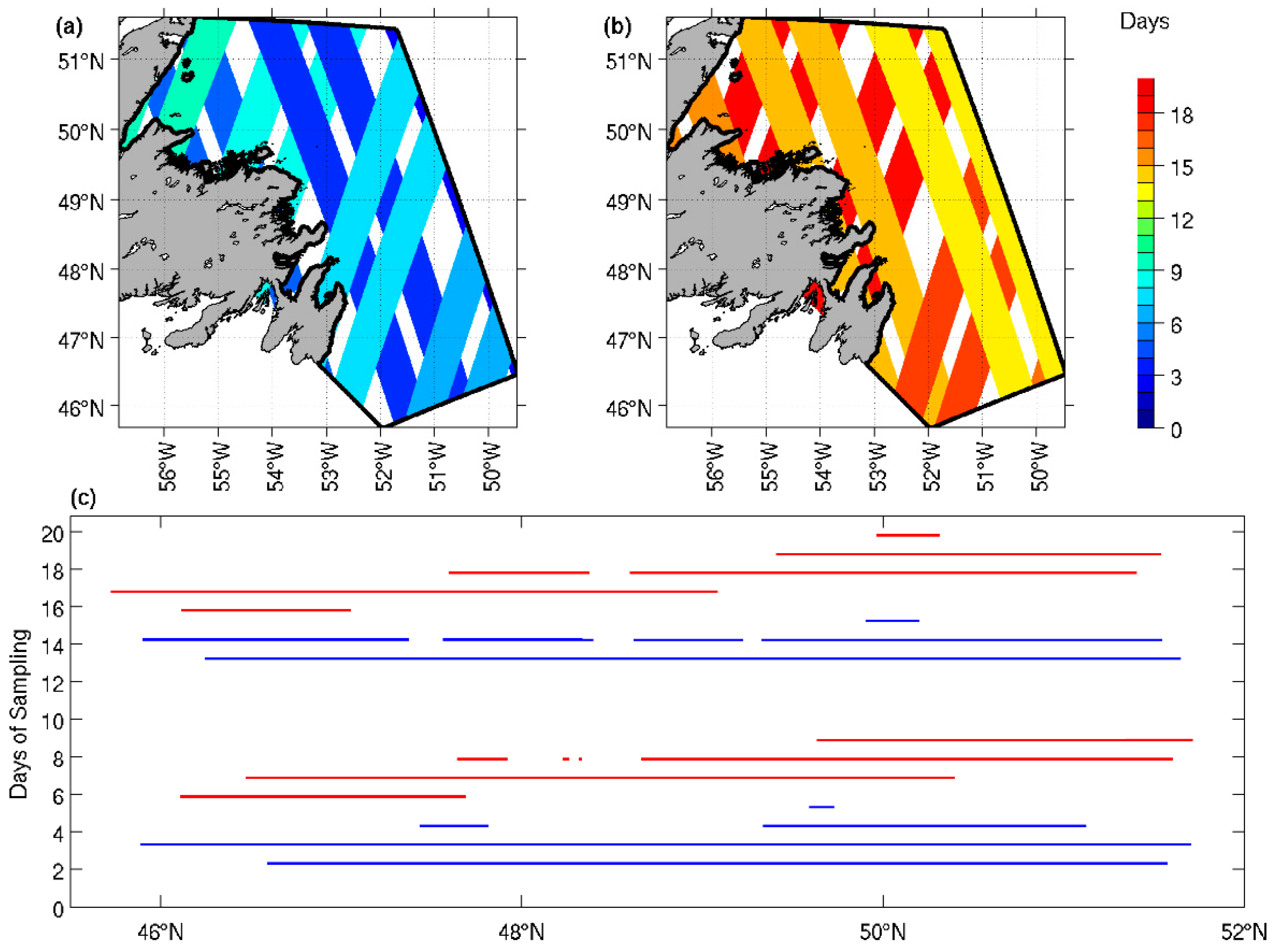


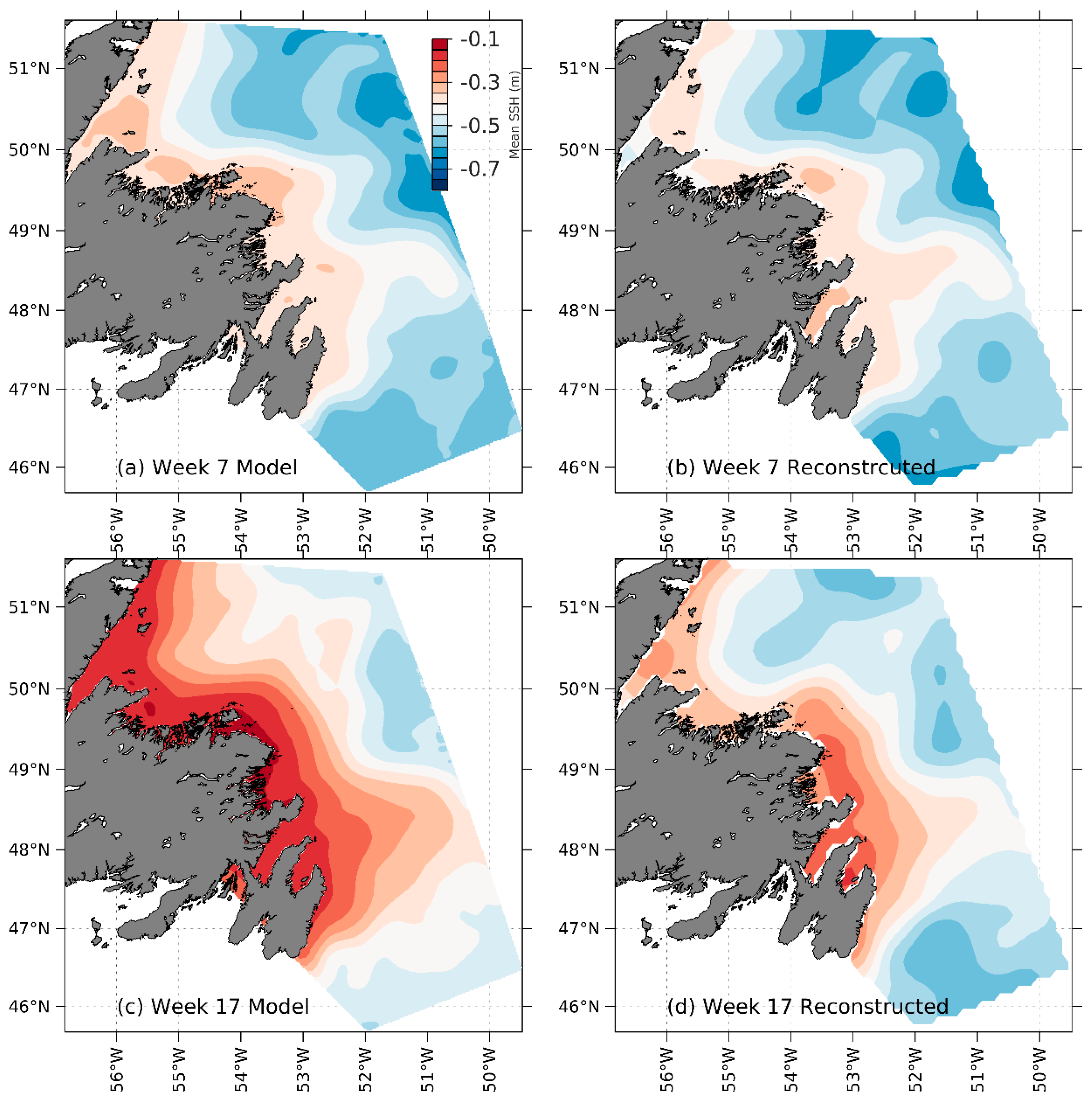

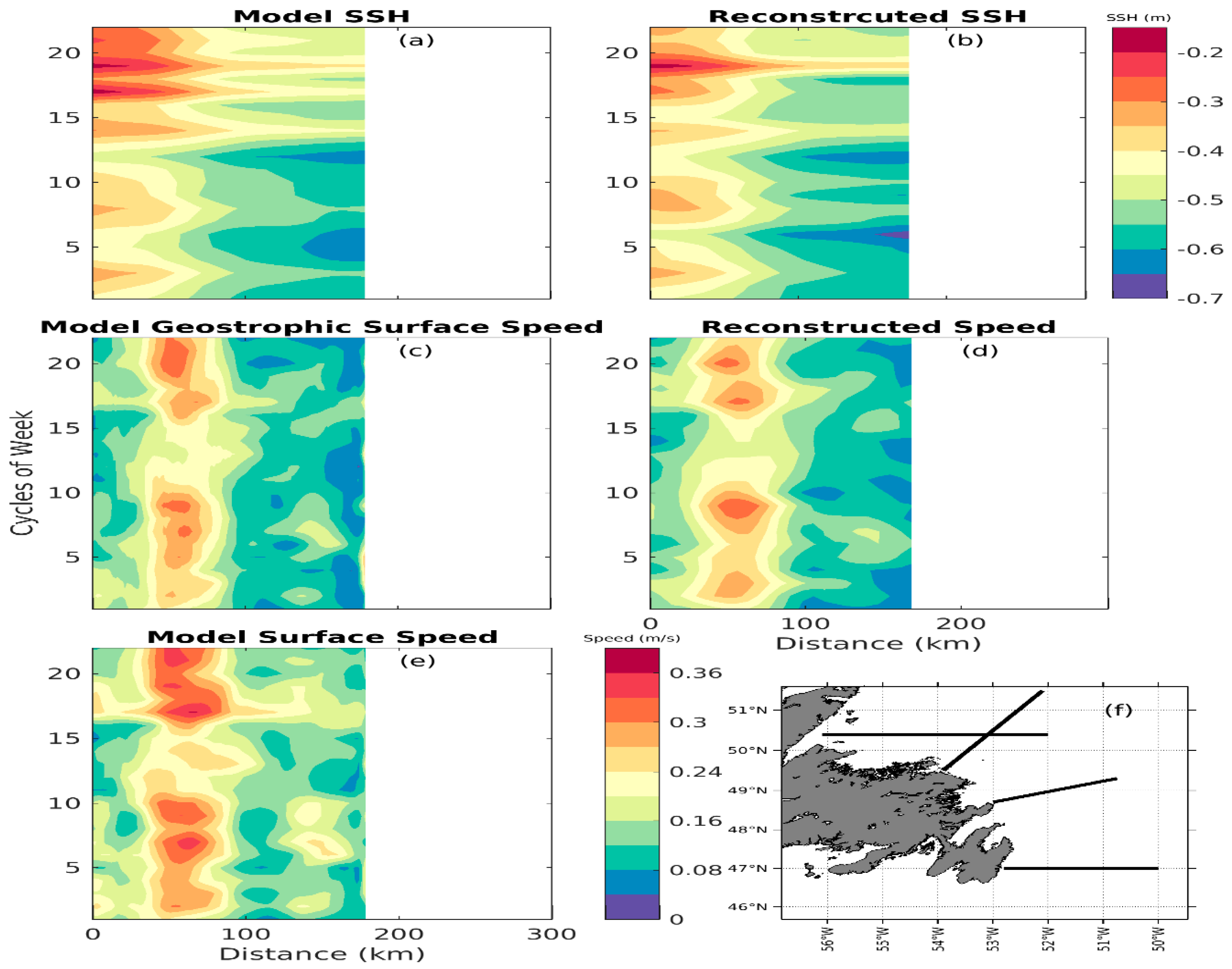
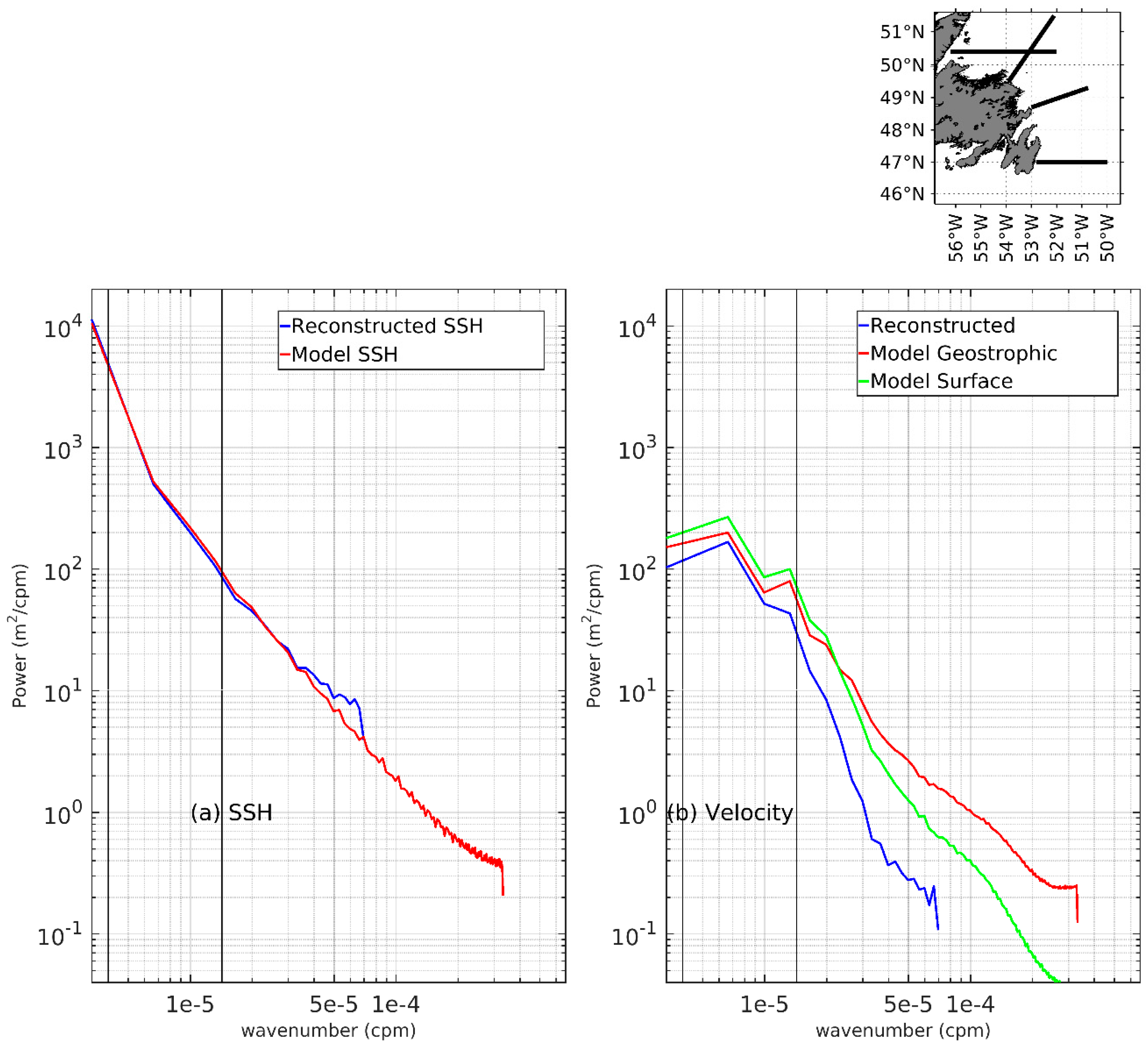

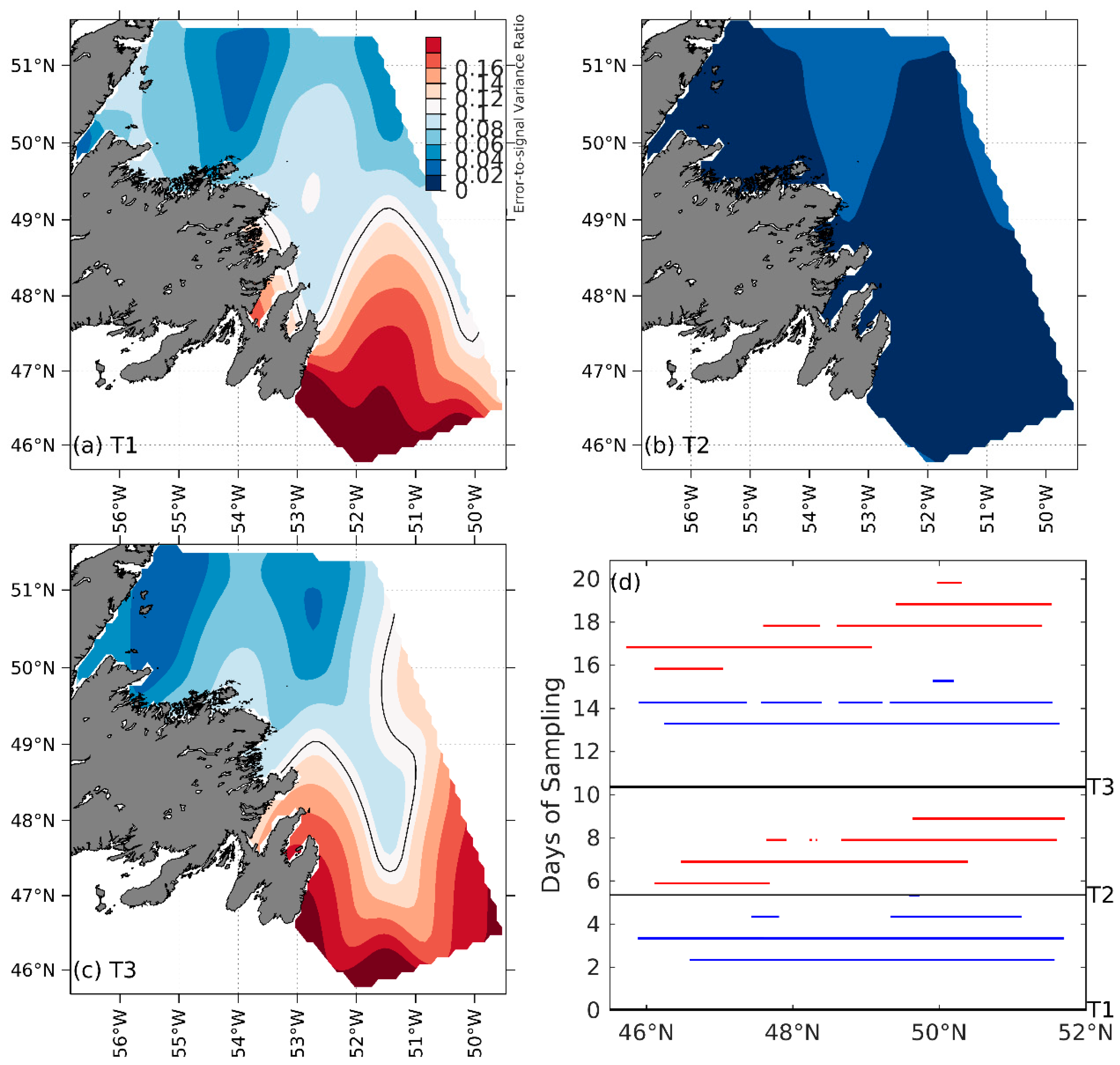
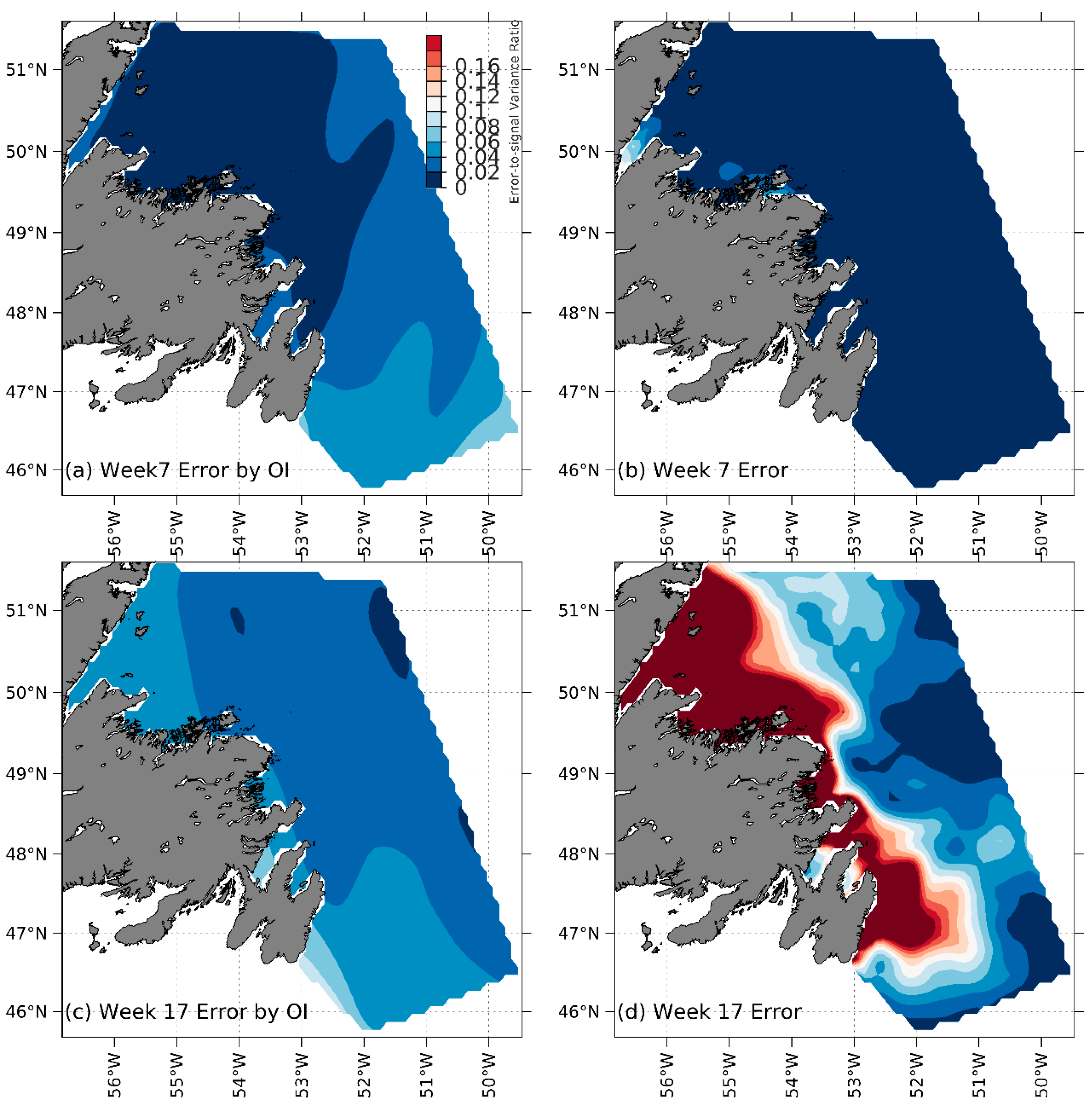
| Spatial Standard Deviation | Root-Mean-Square Error of Normalized Spatial Patterns | Temporal Standard Deviation (m) | Root-Mean-Square Error of Normalized Temporal Patterns | |
|---|---|---|---|---|
| Jason-2 | 0.05 | 0.73 | 0.54 | 0.40 |
| Model | 0.06 | 0.55 |
| Reconstructed Transport Versus Model Transport | Model Geostrophic Transport Versus Model Transport | |||||
|---|---|---|---|---|---|---|
| RMS ErrorUnit: mSv/m | Normalized RMSD | Correlation Coefficient | RMS ErrorUnit: mSv/m | Normalized RMSD | Correlation Coefficient | |
| White Bay | 5.3 | 0.38 | 0.49 | 3.9 | 0.28 | 0.77 |
| Bonavista | 6.0 | 0.32 | 0.63 | 4.1 | 0.22 | 0.87 |
| Flemish Cap | 6.5 | 0.35 | 0.38 | 5.7 | 0.31 | 0.80 |
© 2019 by the authors. Licensee MDPI, Basel, Switzerland. This article is an open access article distributed under the terms and conditions of the Creative Commons Attribution (CC BY) license (http://creativecommons.org/licenses/by/4.0/).
Share and Cite
Ma, Z.; Han, G. Reconstruction of the Surface Inshore Labrador Current from SWOT Sea Surface Height Measurements. Remote Sens. 2019, 11, 1264. https://doi.org/10.3390/rs11111264
Ma Z, Han G. Reconstruction of the Surface Inshore Labrador Current from SWOT Sea Surface Height Measurements. Remote Sensing. 2019; 11(11):1264. https://doi.org/10.3390/rs11111264
Chicago/Turabian StyleMa, Zhimin, and Guoqi Han. 2019. "Reconstruction of the Surface Inshore Labrador Current from SWOT Sea Surface Height Measurements" Remote Sensing 11, no. 11: 1264. https://doi.org/10.3390/rs11111264
APA StyleMa, Z., & Han, G. (2019). Reconstruction of the Surface Inshore Labrador Current from SWOT Sea Surface Height Measurements. Remote Sensing, 11(11), 1264. https://doi.org/10.3390/rs11111264



